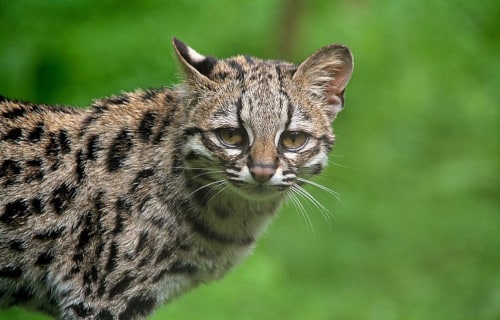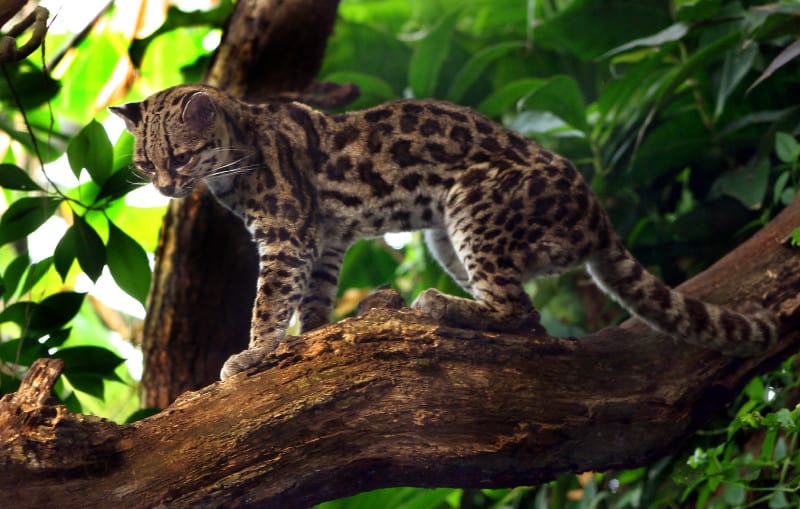Margay Facts
- The deceptively unprepossessing short term of Margay serves as the most frequently used common name of a truly stunning species of wildcat. The animal does hold other general titles, though. These include Tiger cat, Tigrillo in Spanish, Caucel, and the confusing Little ocelot.
- Inside of the scientific world, however, it’s probably more often known by its technical moniker. As such epithets go, though, it’s comparatively simple for the layperson to pronounce. That’s because the marvel of Nature and evolution bears the official name Leopardus wiedii.
- It received that appellation due to the efforts of Heinrich Rudolf Schinz. That highly respected Swiss naturalist accomplished the first formally recorded recognition of it as a separate and distinct species. He achieved that scientifically noteworthy deed in the year 1821.
- This highly evolved cat has distinctive attributes belied by its seemingly simple outward nature. For this reason, many researchers consider it a fascinating product of evolution. Among these factors lies the fact that scattered reports indicate it imitates the calls of prey to lure them in!
- The Margay now finds itself in a precarious position. Horrendously, some people in its native range still slaughter an average of 14,000 of them each year for their fur. Partly due to the population loss derived from this, the IUCN lists the marvelous Margay as Near Threatened.
- Yet, it also faces numerous other potential threats to its continued existence as a species. In this, it deals with the same dangers as all other forms of life on earth today. Most of those perils stem from the actions of man. They include the issues of habitat loss and climate change.
Related Articles
Margay Physical Description
Like many of its relatives, the gorgeous Margay generally instantly captivates those individuals fortunate enough to encounter one. That’s especially true if that meeting takes place in the wild. Unlike some of those same kin, however, it rarely grabs one’s attention due to physical dimensions.
It’s actually smaller than many other wildcats. The stunning creature also displays a certain degree of the phsyiological characteristic of sexual dimorphism. In its spcific case, though, that trait manifests itself in terms of pure physical size. Even then, gender-based differences remain minor.
This principally appears in terms of body mass, and related shape. Males of the species typically attain marginally greater weights than their female counterparts. That sex averages 7.7 – 8.8 lb (3.5 – 4 kg). Females, meanwhile, usually range from somewhere between 5.7 – 7.7 lb (2.6 – 3.5 kg).
Specimens of both sexes develop the same approximate range of body length. This varies widely, ranging from 19 – 31 in (48 – 79 cm). Given the tendency to have the roughly the same length, but different masses, males typically present a moderately stockier build than that of the females.
One feature that quickly gains notice is the tail of the animal. The range in length of this remains the same for both genders, a surprising 13 – 20 in (33 – 51 cm). Astonishingly, that represents roughly 70% as long as the body of the creature itself! That’s far longer than average for wild felines.
Its fur also displays a distinctive pattern. This usually displays as golden-brown to grayish, with a white underbelly. Dark rosettes and streaks appear on the body, with stripes on the tail and legs. Large eyes with dark rings around them and distinctive white markings also show above the eyes.
Yet, perhaps the most distinctive feature of the Margay remains the fact that it has a remarkable evolutionary adaptation in its ankles. These evolved to be so flexible that the cats actually has the ability to walk down a tree trunk headfirst. It’s one of only two known to possess this ability.
- Kingdom: Animalia
- Phylum: Chordata
- Class: Mammalia
- Order: Carnivora
- Family: Felidae
- Genus: Leopardus
- Species: L. wiedii
Margay Distribution, Habitat, and Ecology
The astounding Margay evolved as indigenous to a lamentably small section of the surface of the earth. Exactly where that zone of habitation lies might surprise a few people, though. It developed as native to a limited portion of sections of North America, Central America, and South America.
Sadly, however, it seems to now be extinct inside the United States. There, evidence indicates that it once ranged as far north as the states of Georgia and Florida. Today, the amazing mammal’s only known presence on that continent lies within the borders of the nation of Mexico.
In Central America, however, it’s spotted in Belize, Guatemala, Honduras, El Salvador, Nicaragua, Costa Rica, and Panama. In the southern portion of its territorial range, the wonder of Nature’s present in Colombia, Venezuela, Ecuador, Peru, Bolivia, Brazil, Paraguay, and Argentina, at least.
One factor which perhaps limited its expansion is the fact that it demonstrates a clear and somewhat restrictive preference regarding its choice of habitat. In the broadest terms, it only thrives within the confines of dense forests in the parts of its range in which it makes its home.
The wildcat primarily resides in either rainforests, cloud forests, or dry forests in all regions. It also prefers mature, undisturbed forests, but shows the ability to adapt to secondary forests. It’s flexible about altitude, however. The animal appears at ranges from sea level up to 9,800 ft (3,000 m).
Not only did the awesome Margay evolve as carnivorous in terms of its diet, it’s also primarily arboreal in nature. In fact, unlike most of its countless relatives across the globe, the great majority of individuals often spend their entire lives within the canopy, rarely ever descending to the ground.
This does, however, along with its size, further limit is options in terms of food. Understandably, it thus preys on animals that share its locale. This mainly includes rats, mice, and squirrels. It will, on occasion, though, manage to catch small monkeys. It augments these with small birds and eggs.
The marvel breeds throughout the year, but mating typically peaks during the rainy season, when the availability of food is usually greater. Gestation typically requires 70 – 80 days. The young generally become fully independent of their mother sometime between the ages of 9 – 12 months.
Species Sharing Its Range
Check out our other articles on 7 Supremely Scintillating Cnidaria, Guinan cock-of-the-rock, Tierra del Fuego, White Witch Moth, Indian Giant Squirrel, Wolf Eel, Kemps Ridley Sea Turtle


